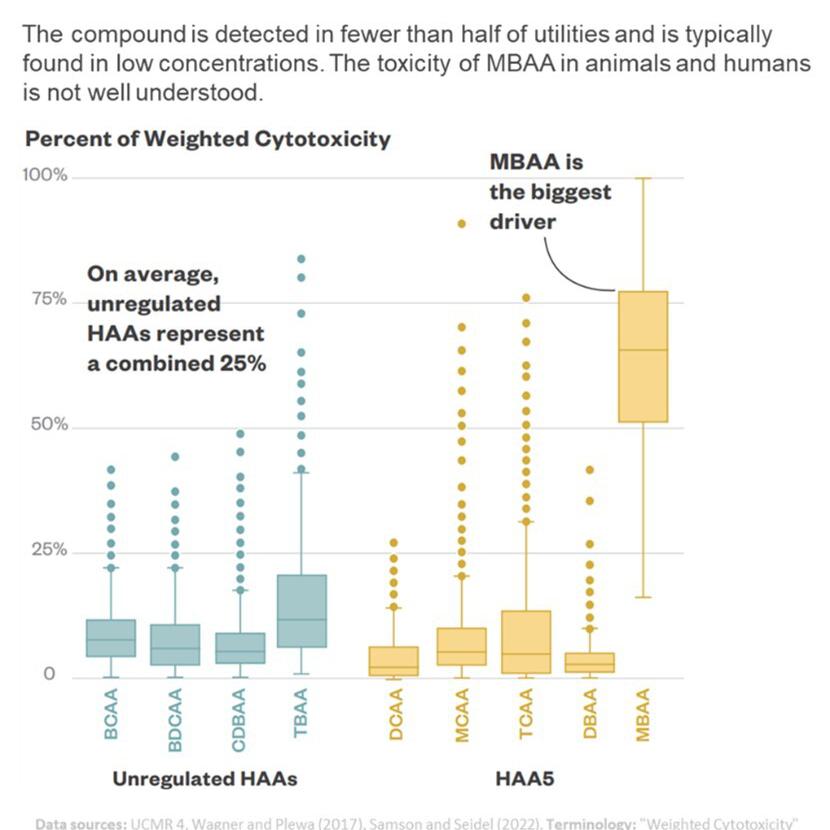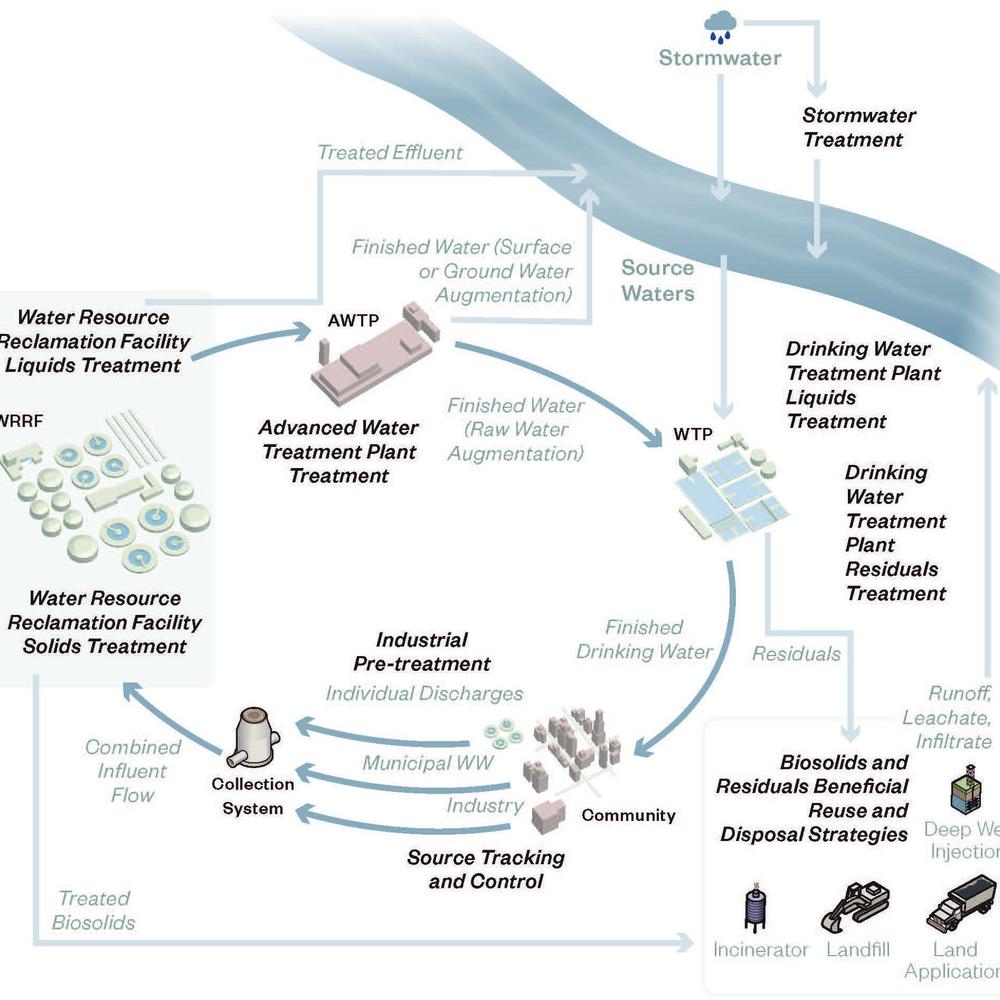Exploring the Conversion of Tertiary Denitrification to Mainstream Deammonification
Last Modified Jul 05, 2022
Introduction and Background
The deammonification process (nitritation-anammox) is a two-step process where ammonium is partially oxidized to nitrite by AOB, and the remaining ammonium is oxidized by AnAOB using nitrite as an electron acceptor to form dinitrogen gas (van Loosdrecht, 2008). Implementing mainstream deammonification could result in a 60% reduction of oxygen demand, approximately 100% reduction in external carbon, and 80% reduction of excess sludge compared to conventional BNR (Jetten et al., 1997; Wett et al., 2007; Daigger, 2014; Cao et al., 2017). Separation of carbon and nitrogen removal is possible with mainstream deammonification, allowing the use of the carbon for biogas production through anaerobic digestion (Jetten et al., 1997; Cao et al., 2017; McCarty, 2018). Siegrist et al. (2008) suggest WWTP energy consumption can be reduced by over 50% using this treatment process with anammox. Traditional applications of deammonification are industrial wastewater treatment and sidestream municipal wastewater treatment (Cao et al., 2017). While there has been success in sidestream deammonification (Lackner et al., 2014; Wett, 2007), mainstream treatment has not been fully realized. The main challenges with mainstream deammonification are high C:N ratios in primary effluent, low free ammonium and free nitrous acid concentrations for NOB suppression, low activity of AnAOB especially at low temperatures, seasonal variation of mainstream wastewater, anammox bacteria retention, and meeting stringent effluent limits (Lackner et al., 2014; Lemaire et al., 2014; Lotti et al., 2015; Xu et al., 2015, Cao et al., 2017).
Significant progress in mainstream deammonification and anammox research has been achieved (Wett, 2007; Ma et al., 2015; Lotti et al., 2016; Cao et al., 2017). Nitritation operations have been studied and proven to work reliably (Ma et al., 2011; Gu et al., 2018). Research into single-stage applications, where nitritation and anammox occur in one reactor, have shown issues with achieving low (< 5 mg/L) effluent TN concentrations (O’Shaughnessy, 2015; Cao et al., 2017). Two-stage applications (separate reactors for nitritation and anammox), while less researched, have more promise with respect to process stability and capability of meeting low effluent TN (Ma et al., 2011; O’Shaughnessy, 2015; Cao et al., 2017; Gu et al., 2018; McCarty, 2018). Different reactor configurations such as moving bed biofilm reactors (MBBR), integrated-fixed film activated sludge (IFAS) systems, and upflow membrane-aerated biofilm reactors (UMABR) have been studied for mainstream applications; however, all would require new infrastructure when implemented at an existing plant (Ma et al., 2011; Lemaire et al., 2014; Li et al., 2015; Regmi et al., 2016; Cao et al., 2017; Gu et al., 2018). An alternative reactor design that utilizes existing infrastructure, reducing costs of implementation, needs to be explored.
A possible option for a two-stage system where existing infrastructure is utilized is the shifting of existing BNR tanks to operate in a nitritation or denitratation mode, coupled with the conversion of existing tertiary denitrification filters to tertiary anammox filters. To date, the use of anammox in a tertiary rapid sand filtration design (i.e., converting denitrification filters) has not been explored for mainstream treatment. Implementing anammox in a filter as a biofilm helps meet the challenge of biomass retention. Converting denitrification filters to anammox filters requires no new structures, minimizing costs for implementation. Minimal process control (e.g., backwashing) is required to maintain filters, which would already be in use at a plant with denitrification filters. Tertiary anammox filters used for polishing can potentially overcome issues with meeting final effluent limits that current single-stage systems have.
In this study, two pilot-scale tertiary anammox filters were operated under mainstream conditions to explore the application of tertiary anammox filters. The goal of this pilot project was to operate and maintain (e.g., backwash) these filters to explore their ability to achieve the TN removal needed to meet low nutrient limits while operating at realistic HRTs and nitrogen loading rates. This research presents a proof of concept for tertiary anammox filters and does not explore the complete two-stage application. The demonstrated reliable performance from the pilot-scale tertiary anammox filters will advance the application of anammox in full-scale, mainstream operation.
Methodology
The two filters utilized in this research had a working bed volume of 33.4 L (1.83 m bed depth, 0.15 m column diameter) and had six ports along the depth for sampling. Sand (effective grain size = 2.75 mm, uniformity coefficient = 1.23, sphericity = 0.90) from the Neuse River Resource Recovery Facility (NRRRF) was used as the media for the filters. Half of the volume of the sand was cleaned by washing in a 10% bleach solution to remove attached biomass; the other half was kept with the attached biomass. Anammox granules were obtained from the Hampton Roads Sanitation District’s full-scale sidestream DEMON process. Approximately 750 mL of underdrain granular sludge was seeded into each filter by pouring the mixed liquor onto the top layer of the media. The mainstream conditions of pH and temperature were ensured by using plant process water as a source, including the variations due to seasonal changes. Source water into the pilot anammox filters was post-denitrification filter effluent from NRRRF stored in a 1900 L tank. “Pseudo-steady state” was defined as the condition when the 3-day average effluent NO2- concentration reached below 1.0 mg/L-N and total inorganic nitrogen (TIN) percent removal was greater than 50%. The hydraulic residence time (HRT) was reduced by 25% when effluent quality met the criteria above. Batch dosing the 1900 L tank in Start-up and Phase 1 used two peristaltic pumps which supplied ammonium and nitrite concentrated solutions (ammonium chloride (NH4Cl) and sodium nitrite (NaNO2)) as the tank was filled using a submersible pump. For Phase 2, the same peristaltic pumps were used to provide in-line dosing of the salt solutions. Each filter had a peristaltic pump feeding dosed water at the correct flow rate.
The Start-up phase was for promoting growth and establishing an anammox population in the filters. Fresh influent was fed to the filters daily in a batch process. The source water tank was dosed every 3 days with targeted ammonium and nitrite concentrations to produce an influent NH4+: NO2- ratio of 1:1.5. Phase 1 extended from Day 1 to Day 76 of continuous flow operation and investigated the effect of clean and previously colonized media on startup performance of the anammox filter. Again, batch dosing of the 1900 L tank at a NH4+:NO2- ratio of 1:1.5 was completed in Phase 1. The filter HRT in Phase 1 started at 90 minutes and was reduced to 66.7 minutes on Day 36. A backwash at a rate of 12 gpm for one to two minutes occurred on Day 69 due to the filter reaching maximum head loss. On Day 76, the dirty media filter was taken offline due to an irreparable leak. Phase 2 covered the continuous flow operation of only the clean media filter from Days 86 to 230. The primary goal of this phase was to explore the filter performance as HRT decreased to realistic values. To estimate the reactor performance at approximately 25-minutes HRT during the overall empty-bed HRT of 37.5 minutes, samples from Ports 4 (22 min.) and 5 (28 min.) were collected and analyzed. At the start of the phase, the NH4+: NO2- ratio was increased to 1:2 due to Phase 1 performance. The NH4+: NO2- ratio was decreased to 1:1.6 on Day 185. Backwashing was completed as needed at a rate of 12 gpm for one to two minutes.
Results
Low nitrite and ammonia in the effluent were achieved in Phase 1, while influent nitrate increased over the first 31 days of continuous operation. After 76 days of operating the pilot filters, performance of the two filters was similar with regard to effluent ammonia and nitrite. The dirty media reactor had slightly lower effluent nitrate and a TIN removal of 39% compared to the 29% TIN removal of the clean media reactor. Based on an initial mass balance, the clean and dirty media filters appeared to have similar maximum anammox activity. Reducing the HRT from 90 to 67 minutes appeared to initiate heterotrophic denitrification in the filters, with a more pronounced effect in the dirty media filter. Both filters showed increased nitrite removal but decreased ammonia removal with the decrease in HRT.
The profile measurements from the clean media filter showed that the majority of the ammonia and nitrite consumption occurred within the first 40 minutes. Some ammonia release was measured at the effluent. Nitrate was produced gradually throughout the column. Soluble COD consumption trended with nitrite removal over nitrate removal. The dirty media reactor profile also showed the majority of the ammonia and nitrite consumption occurred within the first 40 minutes of the filter depth. Nitrite became a limiting factor for the system after 40 minutes. Some ammonia release was observed at the effluent, and nitrate was consumed throughout the column.
Phase 2 results for the clean media reactor show that at steady state, the ammonia removal was greater than 95% and the nitrite removal was approximately 92%. Steady state TIN removal averaged 64%. On Day 150, the HRT was decreased from 67 to 50 minutes. After around 25 days, the ammonia removal stabilized to about 95%. The nitrite stabilized to under 1 mg/L NO2-N in the same time, with around 89% of the nitrite being removed. Nitrate production decreased after the change to 50 minutes. At steady state, the nitrate production increased. The HRT was again decreased during this phase from 50 minutes to 37.5 minutes on Day 190. There was no loss of performance with the decrease in HRT. Ammonia and nitrite removal averaged 94% and 96%, respectively, after 7 days of operating at a 37.5-min HRT. Nitrate production increased during the 37.5-min HRT than compared to the 50-min HRT; however, TIN percent removal increased due to the better ammonia and nitrite removals. Average ammonia and nitrite removals at Port 4, an effective HRT of 21.9 minutes, of 84% and 89%, respectively, demonstrate the majority of removal has occurred within the top layers of the filter.
In the profile prior to backwashing, the majority of the removal occurred within the first 30 minutes of the reactor flow through the media, whereas in the post-backwash profile, the entire reactor depth (equivalent HRT) was required to remove the constituents. Data taken a day after backwashing indicated that the filter has already started to recover, with the ammonia and nitrite removal rates at 81% and 75%, respectively.
Conclusions
This research successfully explored the feasibility of applying anammox filters to mainstream wastewater treatment for N removal. Anammox in mainstream treatment is a promising alternative to conventional N removal processes because of the benefits provided. At the longer HRTs, TIN removal was higher in the dirty media filter than the clean media filter, suggesting the replacement of current denitrification filters may not be needed. The anammox filter was shown to meet a low TIN effluent concentration of below 5 mg/L at realistic filter HRTs. Nitrate was the limiting factor in reaching lower effluent concentrations. Controlling nitrate in the influent and nitrate production within the filter will be a major issue affecting the filter performance.
DNA extraction and metagenomic analysis to determine the dominant species and the changes in microbial community throughout filter operation will be completed. Within the bigger picture of this technology application, developing an upstream control process to feed the desired influent NH4+:NO2- ratio needs to be researched. Studies investigating the effects of higher DO wastewaters on anammox filter performance and community distributions is also of importance. Exploring partial denitrification further with the anammox filter and conducting the same “stress” experiments on a dirty media filter should be considered in future research.











